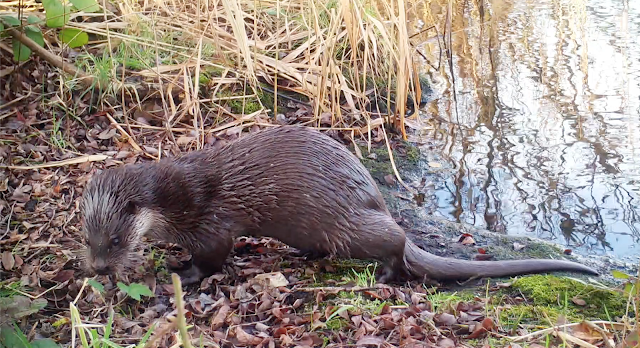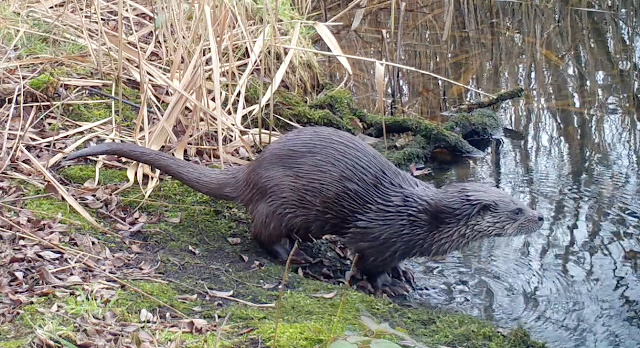The otters have been putting on a show recently, appearing on the cameras several times in daylight. One of the limitations of trail cameras is that the target has to be in the frame before the camera is activated and, with a 400ms activation time, it means that the start of the action is missed, a big deal if it is something very fast like a weasel. Another limitation is that Browning cameras record for only 20s at night, although they will restart very quickly and clips can be stitched together. Just occasionally everything works out perfectly, as in this first video. The dog otter swam into view briefly to activate the camera, disappeared momentarily, and reappeared for about 20s, all of which was recorded as the camera will run for up to 2 minutes in daylight.
My Blog List
Thursday, 27 January 2022
OtterCam in January
Here is another daylight sequence, showing a smaller otter on two cameras, either last year's cub or the resident female. It has been in the wars and has an injury on its upper lip, perhaps from fighting. You can see that both otters were very aware of the camera.
This little gully is a favourite spot of the otters' (and mine) and they use it a lot for scent-marking, as well as a way of getting from the lake to the reed beds. Here the dog pops in to sniff the camera and to check for messages and leave his own before returning to the water. The bright sun and deep shadow made the lighting more difficult.
The next video records something I haven't seen before on the trail camera. The dog otter caught a fish and sat down to eat it, tantalisingly just a few inches outside the field of view of the camera for the next four minutes, a case of what might have been. We can hear the crunching noises but can't see the action. When the otter came back for a drink and a scratch of course he was bang in the middle of the frame. My friend Phil, an ace fisherman himself, tells me this is a perch, probably weighing about 8-12 oz. Paul Chanin's book Otters says that a mature dog otter needs about 1.5kg of fish a day so this otter will eat 4-6 of these a day.
There was an auxiliary movement-triggered infrared light back left just out of view and you can see the improvement in the picture when it switches on.
After that I put in an extra camera at the top of the bank. It was on a pole that has been in place for a long time but the camera was new and would have been silhouetted against the sky from the otter's viewpoint. When I first saw this sequence of the otter with a sore nose I thought it had been spooked by the new camera and was trying to get by, even though it has been passing lower cameras every day for the last six months or more. I now think it was just playing and towards the end you can see it was even trying to get the camera to join in. It reminds me in a way of its distant cousin the stoat. The sequence is a bit disjointed and was difficult to stitch together, partly because of the camera's reaction time and recording only 20s at a time, but I think it is worth seeing.
And finally the latest video from yesterday. This again is the smaller otter calling in at the bottom of the bank to leave its scent mark. At least one of these otters does this here every day.
Subscribe to:
Post Comments (Atom)
















No comments:
Post a Comment